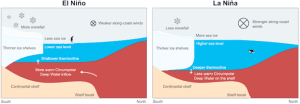TAG: GS 1: GEOGRAPHY
THE CONTEXT: Heat from El Niño can warm oceans off West Antarctica – and melt floating ice shelves from below.
EXPLANATION:
- Recent studies using satellite data have revealed that West Antarctic ice shelves experience a paradoxical phenomenon during El Niño events.
- While they gain height due to increased snowfall at the surface, they also lose mass as warm water melts the ice from below.
- This underscores the complex interplay between atmospheric and oceanic processes in shaping Antarctic climate dynamics.
- The dynamics of climate change are complex and multifaceted, with natural climate drivers like the El Niño-Southern Oscillation (ENSO) playing a significant role in influencing regional weather patterns and global climate trends.
- In the context of Antarctica, the effects of El Niño on West Antarctic ice shelves have garnered attention due to their implications for sea level rise and the stability of the Antarctic ice sheet.
- West Antarctic ice shelves, floating extensions of the continent-sized glacier, are crucial components of the Antarctic ice sheet.
- These ice shelves play a critical role in regulating sea level by stabilizing the flow of ice from the continent into the ocean.
- However, they are vulnerable to melting from below when ocean temperatures rise, contributing to global sea level rise.

During El Niño, weaker winds along the coasts push less cold Antarctic surface waters towards the continent, allowing warmer Circumpolar Deep Water to flow to the base of the ice shelves. During La Niña, stronger winds drive a wedge of cold water up towards the continent, reducing the inflow of warm water.
Impact of El Niño on Antarctic Climate
- El Niño and its counterpart La Niña are phases of the ENSO cycle that influence weather patterns and ocean temperatures across the Pacific region and beyond.
- While Australians are familiar with the local effects of El Niño and La Niña, these climate drivers also have far-reaching impacts, including on Antarctica.
Mechanism of Influence
- During El Niño, convective thunderstorms in the Pacific Ocean generate atmospheric waves that propagate eastward and eventually reach Antarctica.
- These waves weaken the easterly winds off West Antarctica, allowing warm water from deeper ocean layers to flow onto the continental shelf and beneath the ice shelves.
- This influx of relatively warm water leads to increased melting of the ice shelves from below.
Challenges in Understanding
- Despite advancements in satellite observations and modeling techniques, several key questions remain unanswered.
- The precise mechanisms by which warm water reaches the base of ice shelves during El Niño events and the corresponding effects during La Niña phases are still being investigated.
- Additionally, the interaction of ENSO with other climate drivers further complicates the analysis of Antarctic climate variability.
Modeling Approaches
- To better understand the influence of El Niño on West Antarctic ice shelves, researchers employ high-resolution global ocean circulation models that incorporate ENSO anomalies.
- By simulating the effects of El Niño and La Niña on ocean currents and temperatures around Antarctica, scientists can elucidate the underlying mechanisms driving ice shelf melting.

During El Niño, high pressure anomalies in the Amundsen Sea (positive sea level pressure, SLP) weaken coastal easterly winds off West Antarctica, while La Niña brings the reverse.
Implications for the Future
- As climate projections indicate a trend towards more frequent and intense El Niño events, the warming of West Antarctic waters is expected to intensify.
- This heightened melting of ice shelves not only accelerates sea level rise but also raises concerns about the stability of the Antarctic ice sheet.
- Continued research is essential for accurately predicting and mitigating the consequences of these changes.
EL-NINO:
- El Niño is characterized by unusually warm ocean temperatures in the Equatorial Pacific, as opposed to La Niña, which is characterized by unusually cold ocean temperatures in the Equatorial Pacific.
- El Niño is an oscillation of the ocean-atmosphere system in the tropical Pacific having important consequences for weather around the globe.
- Among these consequences are increased rainfall across the southern tier of the US and in Peru, which has caused destructive flooding, and drought in the West Pacific, sometimes associated with devastating brush fires in Australia.
- Observations of conditions in the tropical Pacific are considered essential for the prediction of short term (a few months to 1 year) climate variations.


